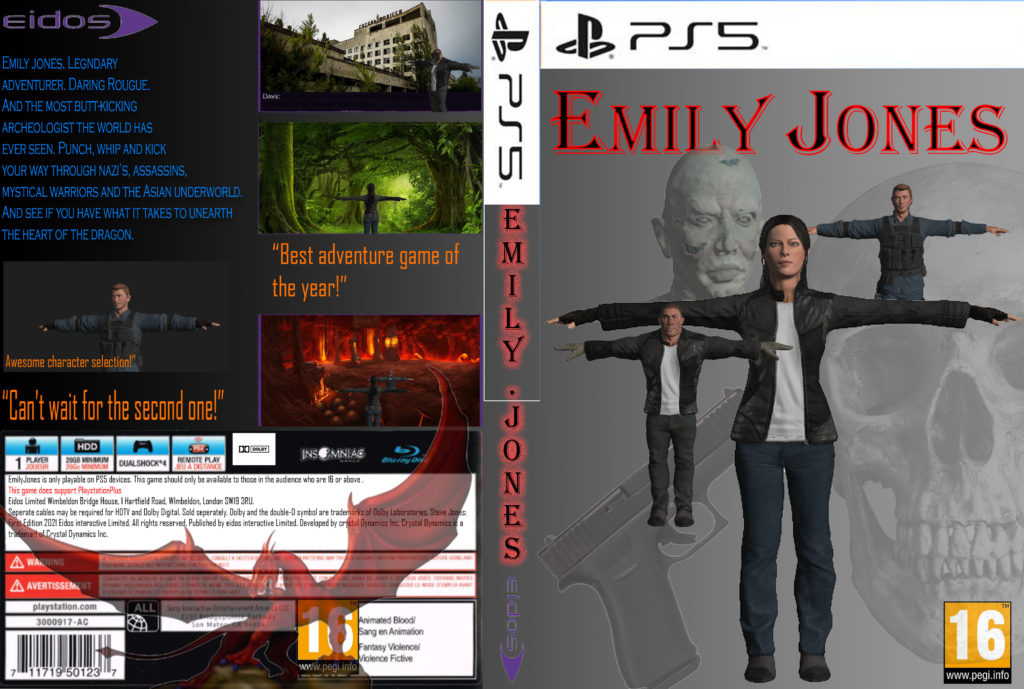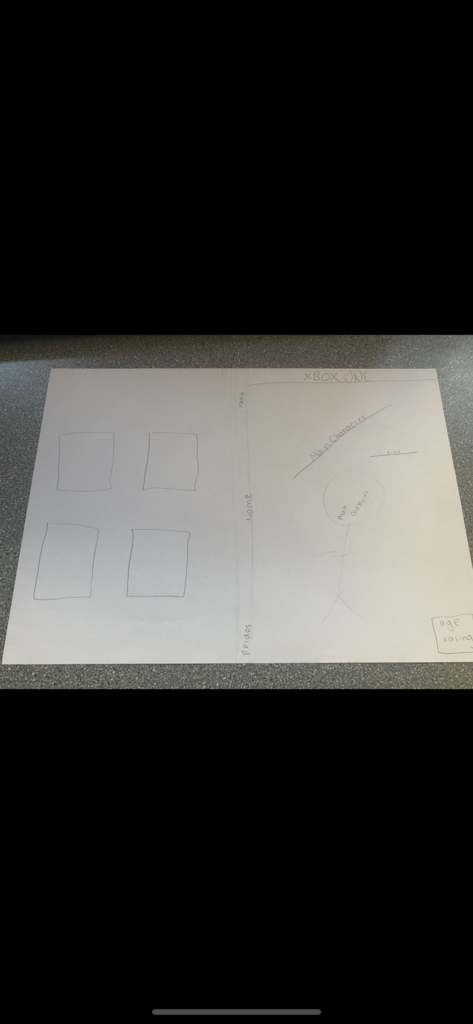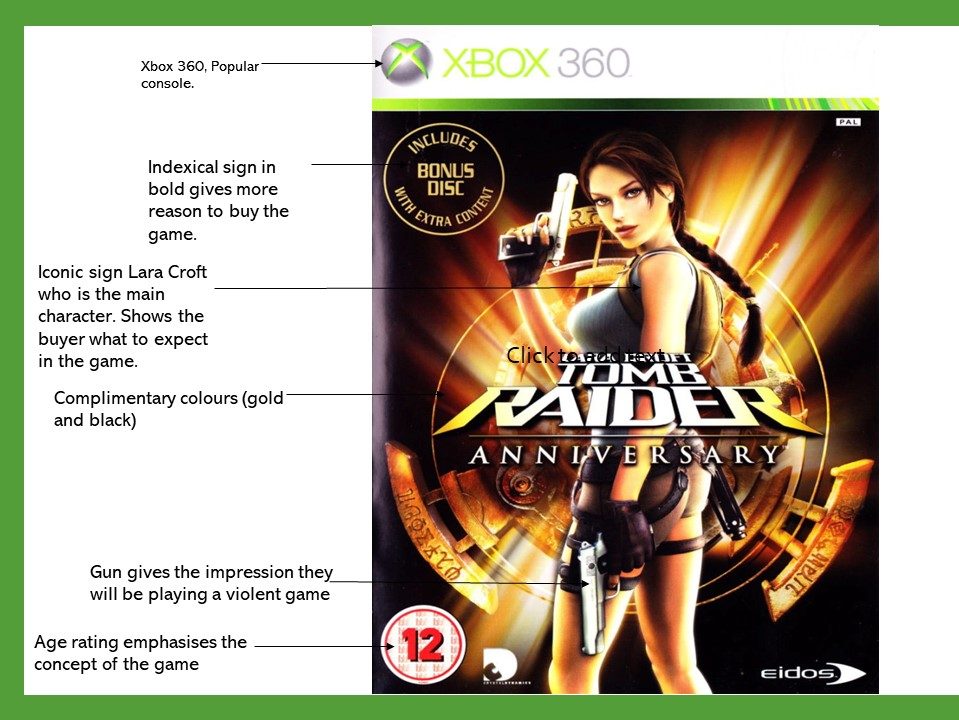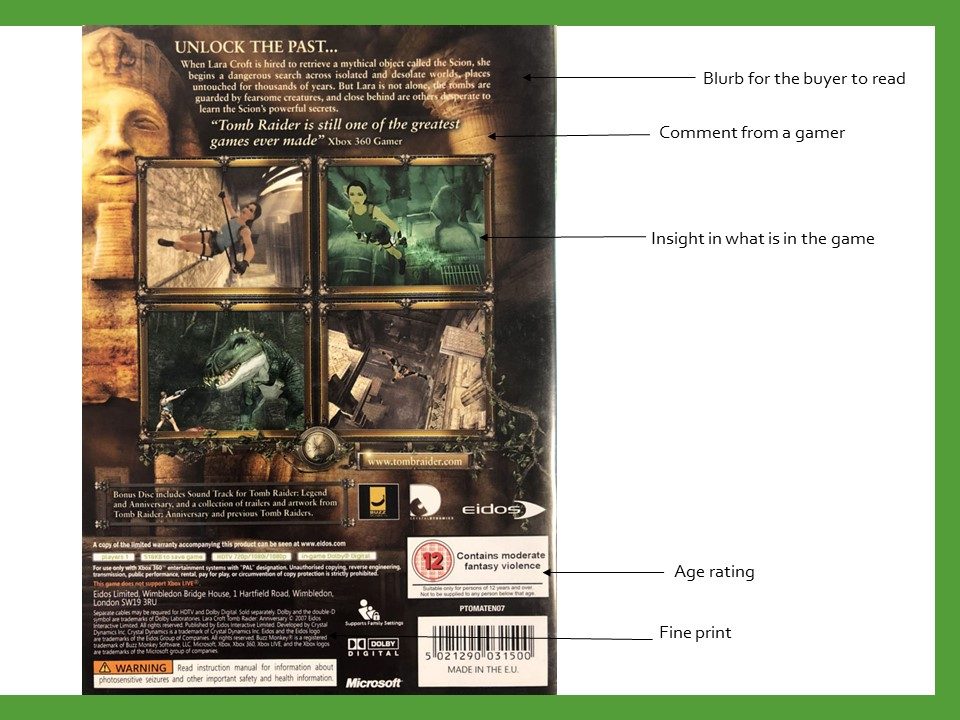Question: ANALYSE THE RELATIONSHIP BETWEEN SIGNIFIERS AND SIGNIFIEDS IN THE TWO CSP GAMES COVERS
in this essay, I am going to comply a semiotic analysis to both Tomb raider and Metroid video games cover, and how they are represented to the audience. I will argue throughout this essay that Tomb raider is a sexist representation of woman, with a negative impact on gamers. On the other hand, I will argue that Metroid illustrates a positive view as the focus is not just on the character, but the whole games cover composition as a whole.
Tomb Raider is an illustration of the way in which the games industry presents reactionary representations of the dominant ideology of females. I could argue that Tomb Raider is a reactionary text. The dominant signifier, Lara Croft, is presented in tight, revealing clothing to attract the male gamers and fulfil their needs. This corresponds to John bergers concept of the male gaze in the sense that, when women are sexualised, male gamers are more attracted to the game. This provides a negative representation on femininity. Furthermore, Lara Croft is designed to be reactionary, with small hips, perfect features, big breasts and a slim body so that the male gamers are interested in the game at first sight.This is expected from the audience as society are accustomed to the idea that women are always going to be objectified and sexualised, supporting the male hegemony. This provides a sexist and patriarchal view on the female body. Personally, I would argue that Tomb Raider is both a radical and reactionary text shown by the way Lara Croft is presented. Lara Croft is an iconic sign, as she resembles a real female human. However, she has been exaggerated through constructed reality as she is presented as a realistic woman, but she has been animated to have unrealistic and farfetched feature. This makes her a unrealistic misrepresentation of the female human, allowing the players to think that this is how all woman should look, raising the patriarchal standards of women in real life. It sets the example that it is excepted that woman are weak and sexualised in society creating an objectifying view of woman. This therefore conforms to the dominant ideology. I would also argue the tomb raider is a radical text as Lara Croft goes against the stereotypical stay-at-home woman in the real world. For example she is portrayed as a strong and powerful character and goes against the damsel in distress stereotype as shown by Anita Sarkeesian in ‘Feminist Frequency’. instead, she is a counter-type, saving and protecting herself, much like her own knight in shining armour, and does not have a male character saving her. This challenges what you would normally expect from a video game which has a niche target market of men. This design choice contrasts to the quote “She falls in love with the main male protagonist and becomes his property losing her outward glamourous characteristics” – Laura Mauvey. This adds a feministic view on the way woman should be portrayed, allowing the gamers to understand that women are capable of anything men can do. I could argue that this is radical as it does not conform with the general stereotype of women within modern day society. In addition, The Tomb Raider games cover may provide a negative representation of women. Lara Croft is holding multiple guns which are very clear on the front cover. The age ratio on the game is a 12, however the guns relate to the idea of death and violence. although the age rating may not be taken seriously or followed correctly, it is suggesting to people of a young age, who are easily impressionable and gullible, that guns are acceptable in society. This allows players to believe that this is acceptable in society based on the game that they have played. This representation of society may not be suitable for such a young age and entices the gamers to have a sexist and aggressive mindset which advocates qualities that people should not want to have.
Contrasting to this, I think Metroid represents feminism in a positive light. At first glance you may not be able to work our quickly whether the character is portrayed a a man or woman, or even any gender at all as it is dressed in an armour suit which covers its natural identity. this leads to the idea that, as you cannot tell the gender of the character, gamers automatically assume that the character is male. This is because violent and aggressive games usually include male characters. However, following BBC’s article, the quote “At first players were led to believe that the hero was a man – the game’s accompanying booklet referred to Samus as a “he”. But those who completed the game fast enough were in for a shock: at the end Samus revealed herself to be a woman.” can provide us with a controversial view in regards to feminism upon the main character Samus. She is said to be one of the most iconic female characters in gaming, but the way she is hidden behind disguising armour could be contentious. In my opinion, this highlights the fact that women can achieve anything a man can and contradicts the stereotypes of a woman being weak and incapable. For gamers, this can educate them to think about more positive ways of representing women and help the gamers adopt to new ways of thinking about gender representation. This here is shown to be a radical decision, as we are all expecting and assuming the character is male. On the other hand, other people may view this as a negative representation of feminism, as they have hidden her behind a facade to lead the viewers into thinking the character is male. Why are they hiding her behind some kind of mask? Without having played the game, or knowing the history of it, you would never guess that Samus is female.
In conclusion, both Tomb Raider and Metroid provide both a radical and reactionary view on feminism. Both provide a positive view on feminism in the sense that, they both present females as the main character, show is strong and powerful and can fight for herself. On the other hand they both provide a negative view on women. In tomb raider, Lara Croft is overly sexualised for the needs of the male hegemony, and in Metroid they hide the girl behind a mask almost like they are hiding her true identity and feminism.



/cdn.vox-cdn.com/uploads/chorus_asset/file/10439457/tombraider.gif)



